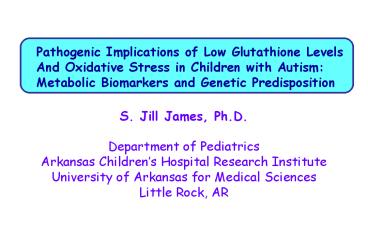S. Jill James, Ph.D. - PowerPoint PPT Presentation
1 / 19
Title:
S. Jill James, Ph.D.
Description:
S. Jill James, Ph.D. Department of Pediatrics. Arkansas Children's Hospital ... S. Jill James, William Slikker, Elizabeth New, Stefanie Jernigan, Stepan Melnyk ... – PowerPoint PPT presentation
Number of Views:109
Avg rating:3.0/5.0
Title: S. Jill James, Ph.D.
1
Pathogenic Implications of Low Glutathione
Levels And Oxidative Stress in Children with
Autism Metabolic Biomarkers and Genetic
Predisposition
S. Jill James, Ph.D. Department of
Pediatrics Arkansas Childrens Hospital Research
Institute University of Arkansas for Medical
Sciences Little Rock, AR
2
ANTIOXIDANT FUNCTION OF GLUTATHIONE
Major intracellular antioxidant H2O2,
superoxide, hydroxyl radical,
peroxynitrite, membrane lipid peroxidation
(active) (inactive)
3
DETOXIFICATION FUNCTIONS OF GLUTATHIONE
Maternal/Fetal Environmental Exposures
GST
Heavy Metals
Glutathione Conjugate
Glutamine
Glycine
Mercapturic Acid (Cysteine conjugate)
Bile and Urine Excretion
Cysteine loss increased requirement for de
novo glutathione synthesis sulfur loss in urine
Detoxification Hg, As, Pb, bind to thiol (SH)
group Metal-cysteine conjugates excreted
4
Neurotoxicity of Thimerosal in Human Brain
Cells is Associated with Glutathione Depletion
Protective Effect of N-Acetyl Cysteine or
Glutathione
S. Jill James, William Slikker, Elizabeth New,
Stefanie Jernigan, Stepan Melnyk
Neurotoxicology, in press, October 2004
5
WORKING HYPOTHESIS
The neurotoxicity of Thimerosal is associated
with depletion of glutathione, the major
intracellular antioxidant Ethyl mercury in
Thimerosal binds to cysteine thiol (SH)
groups on intracellular proteins and inactivates
function. The cysteine-SH group of
glutathione, binds mercury and protects
essential proteins from functional inactivation.
Glutathione is the major mechanism of mercury
detoxification
6
Intracellular glutathione levels in cells exposed
to 15 ?M Thimerosal (T) in presence of 100 ?M
N-acetylcysteine (NAC) or glutathione ethyl ester
(GSH)
GLIOBLASTOMA NEUROBLASTOMA
Intracellular GSH (nmol/mg protein)
Control T TNAC TGSH
Control T TNAC TGSH
7
POTENTIAL IMPLICATION
Children with nutritional or genetic
deficiencies in glutathione synthesis may be
less able to excrete mercury/heavy metals and
will reach the critical threshold for
developmental damage at lower level than those
not at risk.
8
Increased Oxidative Stress and Impaired
Methylation Capacity in Children with Autism
Metabolic Biomarkers and Genetic Predisposition
S. Jill James, Ph.D., Laurette Janak, M.O.M.,
Stepan Melnyk, Ph.D., Stefanie Jernigan, Paul
Cutler, M.D.
American Journal of Clinical Nutrition, in
press, December 2004
9
Folate-Dependent Methionine Cycle
Methionine
Protein synthesis
THF
SAM
Methylation of DNA, RNA, Proteins,
Catecholamines, Phospholipids, Creatine
MTase
MS
SAH
B12
AK
SAHH
AMP
Adenosine
5-CH3THF
ADA
Homocysteine
Inosine
THF tetrahydrofolate
Enzymes
10
Methionine Transsulfuration to Cysteine and
Glutathione
Methionine
Protein synthesis
THF
SAM
Methylation of DNA, RNA, Proteins,
Catecholamines, Phospholipids, Creatine
MTase
MS
SAH
B12
AK
SAHH
AMP
Adenosine
5-CH3THF
ADA
Homocysteine
Inosine
CBS
B6
B6
THF tetrahydrofolate
Cystathionine
B6
Transsulfuration Pathway
Cysteine
Enzymes
Glutathione
11
Methionine Cycle Metabolites
Control Children Autistic
Children p value n33
n20
Methionine (µmol/L) 31.5 ? 5.7 19.3 ?
9.7 0.001 SAM (nmol/L) 96.9 ? 12
75.8 ? 16.2 0.01 SAH
(nmol/L) 19.4 ? 3.4 28.9 ? 7.2
0.001 SAM/SAH ratio 5.2 ? 1.3
2.9 ? 0.8 0.001 Adenosine (µmol/L) 0.27 ?
0.1 0.39 ? 0.2
0.05 Homocysteine (µmol/L) 6.4 ? 1.3
5.8 ? 1.0 0.01
12
INTERPRETATION
- The decrease in methionine and homocysteine
levels in autistic children indicates that they
have reduced methionine synthase activity and
reduced turnover of the methionine cycle. - The decrease in SAM and increase in SAH provides
metabolic evidence that methylation capacity is
reduced in some autistic children.
13
Transsulfuration Metabolites
Control Children Autistic Children
p value n33
n20
Homocysteine (µmol/L) 6.4 ? 1.3 5.8
? 1.0 0.01 Cystathionine (µmol/L) 0.17
? 0.05 0.14 ? 0.06 0.002 Cysteine
(µmol/L) 202 ? 17 163 ? 15
0.001 Total glutathione (µmol/L) 7.6 ? 1.4
4.1 ? 0.5 0.001 Oxidized
Glutathione (nmol/L) 0.32 ? 0.1 0.55 ?
0.2 0.001 GSH/GSSG Ratio 25.5 ?
8.9 8.6 ? 3.5 0.001
14
INTERPRETATION
- The significant decreases in homocysteine,
cystathionine, cysteine and glutathione indicate
that glutathione synthesis is depressed in
autistic children. - 2.The increase in GSSG (oxidized inactive
glutathione) and decrease in GSH (active
antioxidant glutathione) is strong evidence that
oxidative stress is increased in autistic
children.
15
Polymorphisms in the Methionine Cycle
Pathway Methylenetetrahydrofolate Reductase
(677C?T1298A?C)
Frequency Odds Ratio p
value 1. MTHFR 677 TT Control Individuals
(183) 10.9 Autistic
Children (231) 13.4 1.26
0.28 2. MTHFR 677 CT Control
Individuals (183) 44.5
Autistic Children (231) 52.8
1.4 0.05 3. MTHFR 677CT/1298AC
Control Individuals (183) 18.1
Autistic Children (231) 26.4
1.6 0.03 4. MTHFR T Allele
Frequency Control Individuals (183)
33 Autistic Children (231)
40 1.33 0.03
16
Polymorphisms Glutathione-S-Transferase
Affecting Antioxidant Capacity
1. GST M1 Null
Frequency Odds Ratio p
value Control Individuals (183)
41.5 Autistic Children (233) 50.6
1.44 0.04 2. GST T1 Null
Control Individuals (183)
25.8 Autistic Children (233) 22.7
0.95 0.42 3. GST M1/T1 Double Null
Control Individuals (183)
8.2 Autistic Children (233)
13.3 1.72 0.05
17
Polymorphisms Associated with Increased
Oxidative Stress
1. Transcobalamin II Frequency
Odds Ratio p value TCII 776GG
Control Individuals (183) 13.6
Autistic Children (216) 26.8 2.53
0.002 2. Catecholamine-O-Methyltransferase
COMT 1947GG Control Individuals
(183) 16.3 Autistic Children
(216) 26 2.34 0.004 3.
Apoprotein E4 (APO E4) (E3/E4 or
E4/E4) Control Individuals (151)
25 Autistic Children (216)
27 0.96 0.48
18
OVERALL CONCLUSIONS NOVEMBER 2004
1. The abnormal metabolic profile in children
with autism is consistent with the abnormal
genetic profile and strengthens the hypothesis
that reduced capacity for glutathione
synthesis in these children may result in a
reduced capacity to detoxify and excrete
environmental metal exposures, including
mercury in vaccines.
19
OVERALL CONCLUSIONS NOVEMBER 2004
- A genetically susceptible subpopulation of
children with reduced glutathione levels and - a reduced capacity to excrete mercury would have
been missed in the population-based epidemiologic
approach used by the IOM to reach their
conclusions. - This plausible possibility warrants further
research support.














![[PDF] DOWNLOAD Yard PowerPoint PPT Presentation](https://s3.amazonaws.com/images.powershow.com/10063183.th0.jpg?_=20240624062)
















